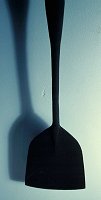Whaling Home | The Whaling Season | Next
Flensing

Flensing is a whaling term that describes the removal of the blubber from the carcass of the dead whale. It is the blubber that contains the oil. This work was carried out while the whale was floating in the water alongside of the whaler (it was too big to be hoisted aboard the ship). The body of each whale was lashed lengthways to the side of the ship. The head was directed towards the stern and the tail was secured by a chain. The flensers then set to work. They used long-handled flensing knives with curved blades, blubber spades and blubber cutters. The main part of the animal was cut up first. The whalebone was then detached and the tail separated. The valuable whalebone was carefully brought onto the deck to be prepared.
A young surgeon aboard the Dundee whaler Narwhal in 1874 describes flensing. [Journal of a voyage to Davis Straits. 1874. Thomas Thorton Macklin Dundee Museum Collection]

The second flensing process was known as Making off. This was the preparation of the blubber pieces for the voyage home. It was usually done in a quiet period when no whales were in the vicinity. It involved cutting the blubber into pieces and removing any bits not required. It was then skinned. Finally, the pieces were placed in a tank ready for the journey home. Macklin also provides a description of making off.
Macklin claims that this process does not smell, but many of the inhabitants of whaling towns would have disagreed. After several months' storage in specially constructed tanks in the ships hold, the raw blubber would arrive back in the home port a little worse for wear. As processing began to extract the oil an offensive smell would pervade the docks. This caused a great deal of displeasure to those living nearby.